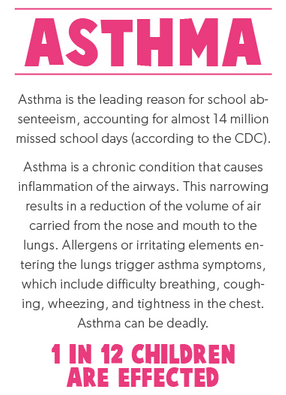The Causes: Color Outside the Lines
The first annual CBHA Color Run is designed to raise awareness of childhood conditions that affect families here in the Columbia Basin. While we may not be able to eliminate these childhood conditions, we can certainly increase awareness, improve education, and support the families who deal with them every day.
Run for a Cause is also an educational celebration of health and movement, and our ability to enjoy community together. We invite everyone to participate on behalf of any of these causes, and in doing so, raise awareness of these conditions.

Asthma
Asthma is the leading reason for school absenteeism, accounting for almost 14 million missed school days (according to the CDC).
Asthma is a chronic condition that causes inflammation of the airways. This narrowing results in a reduction of the volume of air carried from the nose and mouth to the lungs. Allergens or irritating elements entering the lungs trigger asthma symptoms, which include difficulty breathing, coughing, wheezing, and tightness in the chest. Asthma can be deadly.
1 in 12 children are Affected
Autism
Autism is a complex neurobehavioral condition that includes impairments in social interaction and developmental language and communication skills combined with rigid, repetitive behaviors. Because of the range of symptoms, this condition is now called Autism Spectrum Disorder (ASD). It covers a large spectrum of symptoms, skills, and levels of impairment.
ASD ranges in severity from a minor disability that somewhat limits an otherwise normal life to a devastating disability that may require institutional care.
1 in 59 children have ASD and
it affects 4 times
as many boys as girls
Down Syndrome
Down syndrome most commonly occurs when additional genetic material alters the course of development and results in the characteristics associated with Down syndrome, which include developmental and cognitive delays and limitations, increased risk of congenital heart defects, respiratory and hearing problems, thyroid conditions and childhood leukemia. Physical characteristics associated with Down syndrome include low muscle tone, small stature, upward slant to eyes, smaller than average ears, and a single deep crease in palm of hand.
1 in 700 babies in the US is
born with Down syndrome
Behavioral Health
Behavioral health issues affect an increasing number of our children each year. Mood disorders, anxiety disorders, behavior or conduct disorders, anxiety disorders and learning disabilities all fall under the umbrella of behavioral health. 37% of students with a behavioral health condition age 14 and older drop out of school.
Children who struggle with behavioral health disorders are at higher risk for poor outcomes in school and in life. Identifying and supporting these at-risk children is paramount to their success, happiness, and future independence.
1 in 5 children ages 13-18 has a behavioral health condition
Childhood Diabetes
Type 1 diabetes occurs when the pancreas is unable to produce insulin. It is usually diagnosed in childhood. Treatment involves lifelong use of insulin, careful blood sugar monitoring, and management of blood sugar levels.
Type 2 diabetes occurs when insulin is not working effectively, resulting in glucose accumulation in the bloodstream. Type 2 diabetes can often be treated with a change in diet, increase of exercise, and maintaining a healthy weight.
In 2017, 208,000 children had a diagnosis of either type 1 or type 2 diabetes in the US
Spinal Muscular Atrophy
SMA belongs to a group of genetic degenerative diseases that cause weakness and deterioration of the voluntary muscles in the arms and legs of infants and children, affecting a child’s ability to walk, stand, swallow, and breathe.
CBHA CEO Nieves Gomes and his wife Valerie lost their first child to SMA in 2013. Liam Gomez was six months old. Today, there are improvements in the treatment for SMA, although more research is needed to reduce its impact and mortality rate.
#1 cause of genetic death in children under age 2